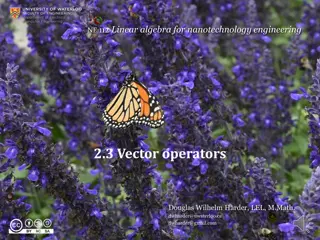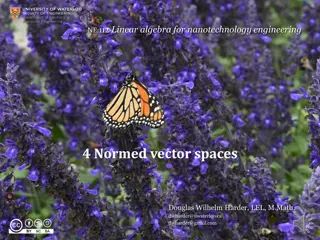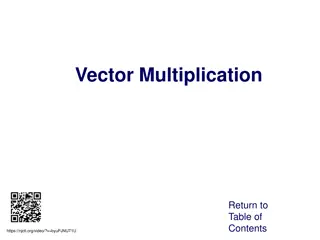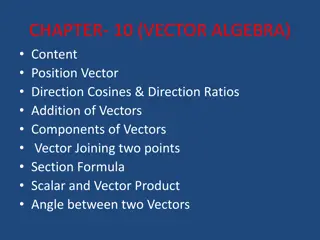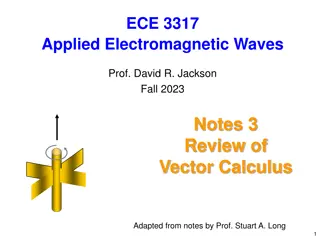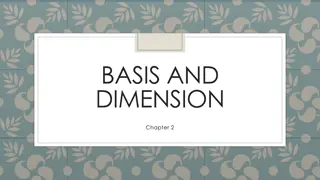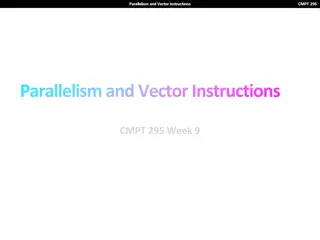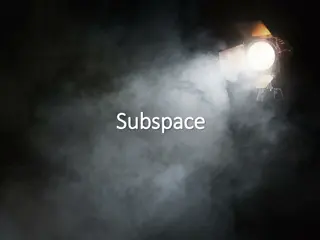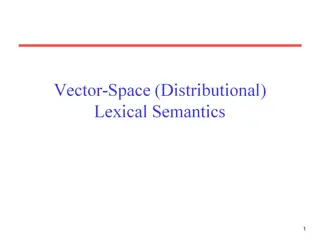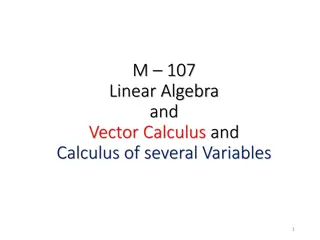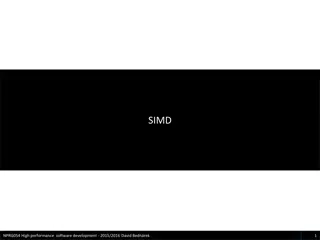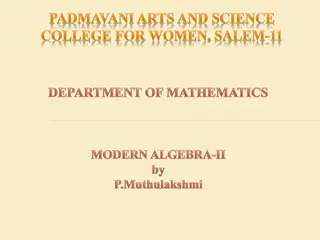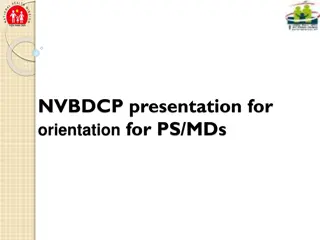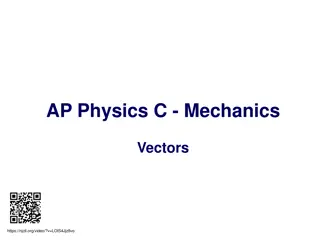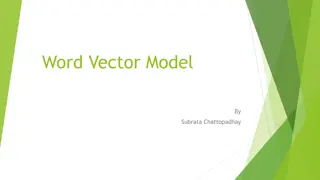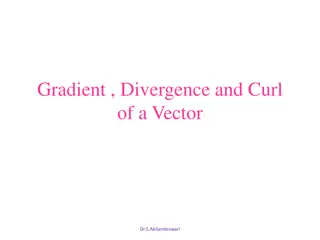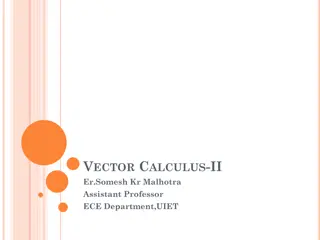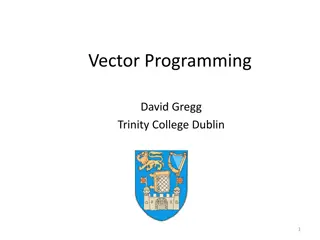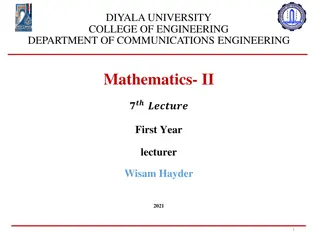
Understanding Vectors and Vector Spaces in Mathematics
Explore the concept of vectors and vector spaces in mathematics, including linear combinations, spans, bases, orthogonal vectors, and subspaces. Discover how functions, matrices, polynomials, and other objects can be considered as vectors. Dive into different vector spaces, operations like addition and scalar multiplication, and the properties that define subspaces.
Download Presentation

Please find below an Image/Link to download the presentation.
The content on the website is provided AS IS for your information and personal use only. It may not be sold, licensed, or shared on other websites without obtaining consent from the author. If you encounter any issues during the download, it is possible that the publisher has removed the file from their server.
You are allowed to download the files provided on this website for personal or commercial use, subject to the condition that they are used lawfully. All files are the property of their respective owners.
The content on the website is provided AS IS for your information and personal use only. It may not be sold, licensed, or shared on other websites without obtaining consent from the author.
E N D
Presentation Transcript
Beyond Vectors Hung-yi Lee
Introduction Many things can be considered as vectors . E.g. a function can be regarded as a vector We can apply the concept we learned on those vectors . Linear combination Span Basis Orthogonal Reference: Chapter 6
Are they vectors? A matrix 1 2 3 4 ? =1 2 4 3 A linear transform A polynomial ?0 ?1 ?? ? ? = ?0+ ?1? + + ????
Are they vectors? What is the zero vector? Any function is a vector? ? ? = ?? ? = ? ? = ? ? = ?2 1 ? h ? = ??+ ?2 1 ? + ?
Rnis a What is a vector? vector space If a set of objects V is a vector space, then the objects are vectors . Vector space: There are operations called addition and scalar multiplication . u, v and w are in V, and a and b are scalars. u+v and au are unique elements of V The following axioms hold: u + v = v + u, (u +v) + w = u +(v + w) There is a zero vector 0 in V such that u + 0 = u There is u in V such that u +(-u) = 0 1u = u, (ab)u = a(bu), a(u+v) = au +av, (a+b)u = au +bu unique
Objects in Different Vector Spaces In Vector Space R1 1 2 3 (1,0) (2,0) (3,0) In Vector Space R2
Objects in Different Vector Spaces All the polynomials with degree less than or equal to 2 as a vector space 1 0 0 0 1 1 1 1 1 ? = ?2+ ? + 1 ? ? = 1 ? ? = ? + 1 Vectors with infinite dimensions All functions as a vector space
Review: Subspace A vector set V is called a subspace if it has the following three properties: 1. The zero vector 0 belongs to V 2. If u and w belong to V, then u+w belongs to V Closed under (vector) addition 3. If u belongs to V, and c is a scalar, then cu belongs to V Closed under scalar multiplication
Are they subspaces? All the functions pass 0 at t0 All the matrices whose trace equal to zero All the matrices of the form ? ? ? + ? 0 All the continuous functions All the polynomials with degree n All the polynomials with degree less than or equal to n P: all polynomials, Pn: all polynomials with degree less than or equal to n
Linear Combination and Span
Linear Combination and Span Matrices 1 0 1,0 0 1 0,0 0 0 ? = 0 1 Linear combination with coefficient a, b, c =? ? ?1 1+ ?0 0 1 0+ ?0 0 0 ? ? 0 0 1 What is Span S? All 2x2 matrices whose trace equal to zero
Linear Combination and Span Polynomials ? = 1,?,?2,?3 Is ? ? = 2 + 3? ?2 linear combination of the vectors in S? ? ? = 2 1 + 3 ? + 1 ?2 ???? 1,?,?2,?3 = ?3 ???? 1,?, ,??, = ?
Linear transformation A mapping (function) T is called linear if for all vectors u, v and scalars c: Preserving vector addition: ? ? + ? = ? ? + ? ? Preserving vector multiplication: ? ?? = ?? ? Is matrix transpose linear? Input: m x n matrices, output: n x m matrices
Linear transformation linear? Derivative: function f e.g. 2x function f e.g. x2 Derivative linear? Integral from a to b scalar ? ? ? ?? function f e.g. x2 Integral ? e.g. 1 (from a to b) 3?3 ?3
Null Space and Range Null Space The null space of T is the set of all vectors such that T(v)=0 What is the null space of matrix transpose? Range The range of T is the set of all images of T. That is, the set of all vectors T(v) for all v in the domain What is the range of matrix transpose?
One-to-one and Onto U: Mm n Mn mdefined by U(A) = AT. Is U one-to-one? Is U onto? D: C C defined by D( f ) = f yes yes Is D one-to-one? Is D onto? D: P3 P3defined by D( f ) = f Is D one-to-one? Is D onto? no no yes no
Isomorphism () Graph Biology Chemistry
Isomorphism W V Let V and W be vector space. A linear transformation T: V W is called an isomorphism if it is one-to-one and onto Invertible linear transform W and V are isomorphic. Example 1: U: Mm n Mn mdefined by U(A) = AT. Example 2: T: P2 R3 ? ? ? ? ? + ?? +? 2?2=
Basis A basis for subspace V is a linearly independent generation set of V.
Independent Example S = {x2 - 3x + 2, 3x2 5x, 2x 3} is a subset of P2. Is it linearly independent? No Example is a subset of 2x2 matrices. Is it linearly independent? Yes implies that a = b = c = 0
If {v1, v2, , vk} are L.I., and T is an isomorphism, {T(v1), T(v2), , T(vk)} are L.I. Independent Example The infinite vector set {1, x, x2, , xn, } Is it linearly independent? icixi= 0 implies ci = 0 for all i. Yes Example Yes Is it linearly independent? S = {et, e2t, e3t} a + b + c=0 aet+ be2t+ ce3t = 0 aet+ 2be2t+ 3ce3t = 0 a + 2b + 3c=0 aet+ 4be2t+ 9ce3t = 0 a + 4b + 9c=0
Basis Example For the subspace of all 2 x 2 matrices, The basis is Dim = 4 Example S = {1, x, x2, , xn, } is a basis of P. Dim = inf
Vector Representation of Object Coordinate Transformation basis ?0 ?1 ?? Basis: {1, x, x2, , xn} Pn: ? ? = ?0+ ?1? + + ????
Matrix Representation of Linear Operator Example: D (derivative): P2 P2 Represent it as a matrix 3 10 0 2 vector vector 3 5 Multiply a matrix 3 + 10? 2 3? + 5?2 polynomial polynomial Derivative
Matrix Representation of Linear Operator Example: D (derivative): P2 P2 Represent it as a matrix 1 0 0 0 0 0 0 2 0 0 1 0 1 0 0 0 0 1 vector vector Multiply a matrix 0 1 0 0 0 0 0 2 0 1 ? ?2 0 1 polynomial polynomial Derivative 2?
Matrix Representation of Linear Operator 0 0 0 1 0 0 0 2 0 5 4 3 Example: D (derivative): P2 P2 Represent it as a matrix Not invertible 4 6 0 5 vector vector 4 3 Multiply a matrix 0 1 0 0 0 0 0 2 0 5 4? + 3?2 polynomial polynomial 4 + 6? Derivative
Matrix Representation of Linear Operator Example: D (derivative): Function set F Function set F Basis of F is ??cos?,??sin? invertible 1 1 1 0 1 1 0 vector vector 1 Multiply a matrix 1 1 1 1 Function in F Function in F Derivative
Matrix Representation of Linear Operator Basis of F is ??cos?,??sin? 1/2 1/2 1/2 1/2 1/2 1/2 0 1 vector vector Multiply a matrix 1 1 Antiderivative 1 1 Function in F Function in F Derivative
Eigenvalue and Eigenvector ? ? = ??, ? 0, v is eigenvector, ? is eigenvalue
Eigenvalue and Eigenvector Consider derivative (linear transformation, input & output are functions) Is ? ? = ??? an eigenvector ? What is the eigenvalue ? Every scalar is an eigenvalue of derivative. Consider Transpose (also linear transformation, input & output are functions) Is ? = 1 an eigenvalue? Symmetric matrices form the eigenspace Symmetric: ??= ? Is ? = 1 an eigenvalue? Skew-symmetric: Skew-symmetric matrices form the eigenspace. ??= ?
Consider Transpose of 2x2 matrices 0 0 0 1 0 1 0 0 0 0 1 0 1 0 0 0 1 0 0 0 0 1 0 0 0 0 1 0 0 0 0 1 vector vector What are the eigenvalues? 1 0 0 0 1 0 0 0 2x2 matrices 2x2 matrices transpose
Eigenvalue and Eigenvector Consider Transpose of 2x2 matrices Matrix Characteristic polynomial representation of transpose ? 13? + 1 ? = 1 ? = 1 Skew-symmetric matrices Symmetric matrices 0 ? 0 ? ? ? ? Dim=3 Dim=1 ?
Norm (length): ? = ?,? Inner Product Orthogonal: Inner product is zero ?,? vector v Inner Product scalar vector u For any vectors u, v and w, and any scalar a, the following axioms hold: 3. ? + ?,? = ?,? + ?,? 1. ?,? > 0 if ? 0 2. ?,? = ?,? 4. ??,? = ? ?,? Dot product is a special case of inner product Can you define other inner product for normal vectors?
Inner Product Inner Product of Matrix ?,? = ????? ??? = ????? ??? Frobenius inner product Element-wise multiplication ? =1 2 4 12+ 22+ 32+ 42 ? = 3
1. ?,? > 0 if ? 0 2. ?,? = ?,? 3. ? + ?,? = ?,? + ?,? Inner Product 4. ??,? = ? ?,? Inner product for general functions Is ? ? = 1 and ? = ? orthogonal? Can it be inner product for general functions? Can it be inner product for polynomials with degree 2?
Orthogonal/Orthonormal Basis Let u be any vector, and w is the orthogonal projection of u on subspace W. Let ? = ?1,?2, ,?? be an orthogonal basis of W. ? = ?1?1+ ?2?2+ + ???? ? ?1 ?1 ? ?2 ?2 ? ?? ?? 2 2 2 Let ? = ?1,?2, ,?? be an orthonormal basis of W. ? = ?1?1+ ?2?2+ + ???? ? ?? ? ?1 ? ?2
Orthogonal Basis Let ?1,?2, ,?? be a basis of a subspace V. How to transform ?1,?2, ,?? into an orthogonal basis ?1,?2, ,??? Gram-Schmidt Process Then ?1,?2, ,?? is an orthogonal basis for W After normalization, you can get orthonormal basis.
Orthogonal/Orthonormal Basis Find orthogonal/orthonormal basis for P2 Define an inner product of P2by ?1,?2,?3 Find a basis {1, x, x2} ?1,?2,?3
Orthogonal/Orthonormal Basis Find orthogonal/orthonormal basis for P2 Define an inner product of P2by Get an orthogonal basis {1, x, x2-1/3} Orthonormal Basis
Fourier Series For all periodic functions with period 2? 2? ?,? = ? ? ? ? ?? 0 2? 2? Orthogonal Basis: Orthonormal Basis: a b ?2+ ?2 ? ??? ? + ??????? ?
(105 ) Introducing general machine learning methods, not only focus on deep learning (105 )

